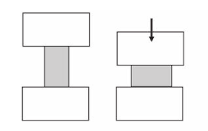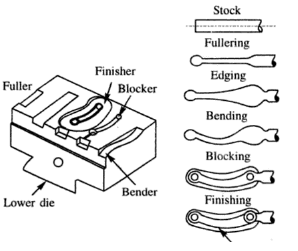Forging
Forging is a basic process in which the work piece is shaped by compressive forces applied through various dies and tooling. It is one of the oldest and most important metalworking operations used to make jewelry, coins, and various implements by hammering metal with tools made of stone. Forged parts now include large rotors for turbines; gears; bolts and rivets; cutlery); hand tools; numerous structural components for machinery, aircraft and railroads and a variety of other transportation equipment.
Simple forging operations can be performed with a heavy hammer and an anvil, as has been done traditionally by blacksmiths. However, most forgings require a set of dies and such equipment as a press or a powered forging hammer.
Forging may be carried out at room temperature (cold forging) or at elevated temperatures (warm or hot forging) depending on the homologous temperature. Cold forging requires higher forces (because of the higher strength of the work piece material), and the work piece material must possess sufficient ductility at room temperature to undergo the necessary deformation without cracking. Cold-forged parts have a good surface finish and dimensional accuracy. Hot forging requires lower forces, but the dimensional accuracy and surface finish of the parts are not as good as in cold forging. Forgings generally are subjected to additional finishing operations, such as heat treating to modify properties and machining to obtain accurate final dimensions and a good surface finish. These finishing operations can be minimized by precision forging, which is an important example of net-shape or near-net-shape
forming processes. As we shall seen components that can be forged successfully also may be manufactured economically by other methods, such as casting, powder metallurgy, or machining .Each of these will produce a part having different characteristics, particularly with regard to strength, toughness, dimensional accuracy, surface finish, and the possibility of internal or external defects.
In forging the material is deformed applying either impact load or gradual load. Based on the type of loading, forging is classified as hammer forging or press forging. Hammer forging involves impact load, while press forging involves gradual loads.
Based on the nature of material flow and constraint on flow by the die/punch, forging is classified as open die forging, impression die forging and flashless forging.
OPEN DIE FORGING
In this, the work piece is compressed between two platens. There is no constraint to material flow in lateral direction. Open die forging is a process by which products are made through a series of incremental deformation using dies of relatively simple shape. The top die is attached to ram and bottom die is attached to the hammer anvil or press bed. Metal work piece is heated above recrystalline temp from 1900 to 24000c.Most open die forging are produced on flat dies. Convex surface dies and concave surface dies are also used in pairs or with flat dies.
Open die forging is classified into three main types, namely, cogging, fullering and edging. Cogging: Cogging (also called as drawing out) consists of a sequence in which the thickness of an ingot is reduced to billet or blooms by narrow dies. Fullering and Edging operations are done to reduce the cross section using convex shaped or concave shaped dies. Material gets distributed and hence gets elongated and reduction in thickness happens. Upsetting is an open die forging in which the billet is subjected to lateral flow by the flat die and punch. Due to friction the material flow across the thickness is non-uniform. Material adjacent to the die gets restrained from flowing, whereas, the material at center flows freely. This causes a phenomenon called barreling in upset forging.
 |
| Open die forging |
IMPRESSION DIE FORGING
Here half the impression of the finished forging is sunk or made in the top die and other half of the impression is sunk in the bottom die. In impression die forging, the work piece is pressed between the dies. As the metal spreads to fill up the cavities sunk in the dies, the requisite shape is formed between the closing dies. Some material which is forced out of the dies is called “flash”. The flash provides some cushioning for the dies, as the top strikes the anvil. The flash around the work piece is cut and discarded as scrap. For a good forging, the impression in the dies has to be completely filled by the material. This may require several blows of the hammer, a single blow may not be sufficient.
CLOSED DIE FORGING
Closed die forging is very similar to impression die forging, but in true closed die forging, the amount of material initially taken is very carefully controlled, so that no flash is formed. Otherwise, the process is similar to impression die forging. It is a technique which is suitable for mass production.
 |
| Closed die forging |
DROP FORGING
Drop forging utilizes a closed impression die to obtain the desired shape of the component. The shaping is done by the repeated hammering given to the material in the die cavity. The equipment used for delivering the blows are called drop hammers.
Drop forging die consists of two halves. The lower half of the die is fixed to the anvil of the machine while the upper half is fixed to the ram. The heated stock is kept in the lower die. While the ram delivers four to five blows on the metal, in quick succession so that the metal spread and completely fills the die cavity. When the two die halves closed the complete cavity is formed.
The die impressions are machined in the die cavity, because of more complex shapes can be obtained in drop forging, compared to smith forging. However too complex shape with internal cavities, deep pockets, cannot be obtained in drop forging. Due to limitation of withdrawal of finished forging from die. The final shape desired in drop forging cannot be obtained directly from the stock in the single pass. Depending upon the shape of the component, the desired grain flow direction and the material should be manipulated in a number of passes. Various passes are used are
Fullering impression:
Since drop forging involves only a reduction in cross section with no upsetting, the very first step to reduce the stock is fullering.The impression machined in the die to achieve this is called fullering impression.
Edging impression:
Also called as preform. This stage is used to gather the exact amount of material required at each cross-section of the finished component. This is the most important stage in drop forging.
Bending impression:
This is required for those parts which have a bend shape. The bend shape can also be obtained without the bending impressions. Then the grain flow direction will not follow the bend shape and thus the point of bend may become weak. To improve the grain flow, therefore a bending impression is incorporated after edging impression.
Blocking impression:
It is also called as semi finshing impression. Blocking is a step before finishing. In forging, it is difficult for the material to flow to deep pockets, sharp corners etc. Hence before the actual shape is obtained, the material is allowed to have one or more blocking impressions where it requires the shape very near to final one. The blocking impression is characterized by large corner radii and fillet but no flash.
Finishing impression:
This is the final impression where the actual shape required obtained. In order to ensure that the metal completely fills the die cavity, a little extra metal is added to the stock. The extra metal will form the flash and surround the forging in the parting plane.
Trimming:
In this stage the extra flash present around the forging is trimmed to get the forging in the usable form.
PRESS FORGING
Press forging dies are similar to drop forging dies as also the process. In press forging the metal is shaped not by means of a series of blows as in drop forging, but by means of a single continuous squeezing action. This squizing is obtained by means of hydraulic presses. Because of continuous action of the hydraulic presses, the material gets uniformly deformed throughout the entire depth. More hammer force is likely to be transmitted to the machine frame in drop forging where in press forging it is absorbed fully by stock. The impression obtained in press forging is clean compared to that of jarred impression which is like in drop forged component. The draft angle in press forging is less than in drop forging. But the press capacity required for deforming is higher and as a result the smaller sized component only are press forged in closed impression dies. The presses have capacities ranging from 5MN to 50 MN for normal application For special heavy duty application, higher capacity press of order 150 MN are required.
To provide the necessary alignment the two halves, die post are attached to the bottom die so that the top die would slide only on the post and thus register the correct alignment. This ensures better tolerance for press forged components.
FORGING DEFECTS
The common forging defects can be traced to defects in raw material, improper heating of material, Faulty design of dies and improper forging practice. Most common defects present in forgings are:
• Laps and Cracks at corners or surfaces lap is caused due to following over of a layer of material over another surface. These defects are caused by improper forging and faulty die design.
• Incomplete forging—either due to less material or inadequate or improper flow of material.
• Mismatched forging due to improperly aligned die halves.
• Scale pits—due to squeezing of scales into the metal surface during hammering action.
• Burnt or overheated metal—due to improper heating.
• Internal cracks in the forging which are caused by use of heavy hammer blows and improperly heated and soaked material.
